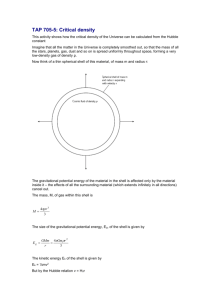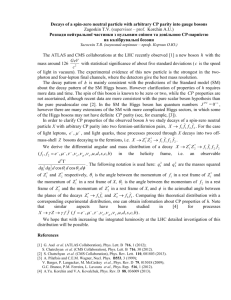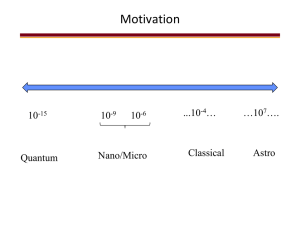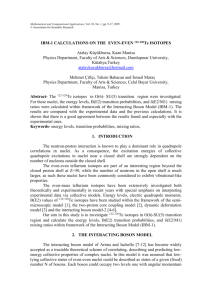Proposal
advertisement
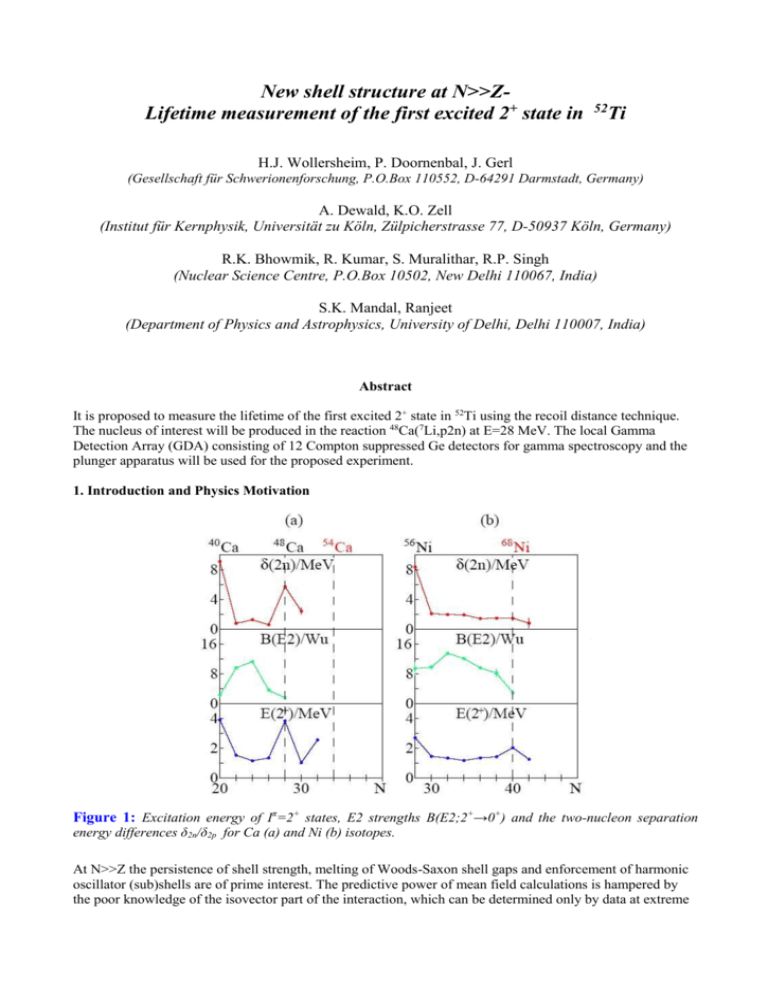
New shell structure at N>>ZLifetime measurement of the first excited 2+ state in 52 Ti H.J. Wollersheim, P. Doornenbal, J. Gerl (Gesellschaft für Schwerionenforschung, P.O.Box 110552, D-64291 Darmstadt, Germany) A. Dewald, K.O. Zell (Institut für Kernphysik, Universität zu Köln, Zülpicherstrasse 77, D-50937 Köln, Germany) R.K. Bhowmik, R. Kumar, S. Muralithar, R.P. Singh (Nuclear Science Centre, P.O.Box 10502, New Delhi 110067, India) S.K. Mandal, Ranjeet (Department of Physics and Astrophysics, University of Delhi, Delhi 110007, India) Abstract It is proposed to measure the lifetime of the first excited 2+ state in 52Ti using the recoil distance technique. The nucleus of interest will be produced in the reaction 48Ca(7Li,p2n) at E=28 MeV. The local Gamma Detection Array (GDA) consisting of 12 Compton suppressed Ge detectors for gamma spectroscopy and the plunger apparatus will be used for the proposed experiment. 1. Introduction and Physics Motivation Figure 1: Excitation energy of Iπ=2+ states, E2 strengths B(E2;2+→0+) and the two-nucleon separation energy differences δ2n/δ2p for Ca (a) and Ni (b) isotopes. At N>>Z the persistence of shell strength, melting of Woods-Saxon shell gaps and enforcement of harmonic oscillator (sub)shells are of prime interest. The predictive power of mean field calculations is hampered by the poor knowledge of the isovector part of the interaction, which can be determined only by data at extreme N/Z ratios. Experimental signature for shell structure are two-nucleon separation energy differences δ2n/δ2p, the Iπ=2+ excitation energies E(2+) and the B(E2;2+→0+) values. The basic experimental features of shell structure at N>>Z for medium-heavy nuclei have been reviewed recently [1]. In Fig.1 experimental signatures for shell structure, the two-nucleon separation energy differences δ2n/δ2p, the Iπ=2+ excitation energies E(2+) and the B(E2;2+→0+) values are shown for several chains of isotopes. In the Ca isotopes (Fig.1a) beyond N=28 a possible (sub)shell closure at N=32,34 seems to develop in E(2+). It has been reported out recently that the Ti and Cr isotopes show a maximum in E(2+) at N=32. On the other hand within the N=34 isotones E(2+) is increasing from Fe to Cr in contrast to the expected trend towards midshell, which supports a N=34 closure. Besides masses, which due to short halflives are difficult to measure, obviously E(2+) and B(E2) values for 50-54Ca are missing for a proof of the concept. Similarly a study of the N=30-34 isotones of Cr and Ti would reveal such a change in shell structure. 2. Status of shell structure in Ti isotopes The even 52-56Ti isotopes have been studied with intermediate-energy Coulomb excitation and absolute B(E2;0+→2+) transition rates have been obtained [2]. Table 1 presents the Iπ=2+ excitation energies E(2+) and the derived B(E2;0+→2+) values. Nucleus 52 Ti 54 Ti 56 Ti E(2+) [keV] 1050 1497 1123 B(E2;0+→2+) [e2fm4] 567(51) 357(63) 599(197) Table 1: Excitation energy of Iπ=2+ states and E2 strengths B(E2;0+→2+) for Ti isotopes. These data confirm the presence of a subshell closure at neutron number N=32 in neutron-rich nuclei above the doubly magic nucleus 48Ca. The B(E2;0+→2+) value for 52Ti agrees with an earlier measurement [3], albeit the errors are large: B(E2;0+→2+)=665(+515,-415) e2fm4. The method of intermediate-energy Coulomb excitation has been used by laboratories with projectile fragmentation facilities to measure absolute B(E2;0+→2+) values. For the neutron-rich 30,32,34Mg isotopes, for example, B(E2;0+→2+) values have been obtained by three groups working in RIKEN [4,5], MSU [6], and GANIL [7]; however, their results are neither conclusive nor consistent. Differences between the data points for a given isotope are as large as a factor of 2. In an attempt to clarify the experimental situation an experimental program was started to measure B(E2;0+→2+) values employing ISOL beams accelerated to energies well below the Coulomb barrier. The measured B(E2;0+→2+) value of 30Mg [8] was determined to be 241(31) e2fm4 and is lower than values obtained at projectile fragmentation facilities using the intermediate-energy Coulomb excitation method. Since intermediate-energy Coulomb excitation depends on a good knowledge of nuclear excitation (as well as nuclear absorption) and the impact parameter determination usually suffers from angular straggling due to the use of rather thick targets, the determination of relative B(E2;0+→2+) values may overcome all the problems mentioned above and are much more accurate. Therefore, one B(E2;0+→2+) value has to be measured with different techniques in the mass region of interest, which is the aim of the present proposal. 3. Proposed experiment We propose to perform a lifetime measurement following 7Li bombardment of 48Ca at E=28 MeV. Previously γ-ray studies of 51Ti, 52Ti and 52V have been performed [3]. However, the lifetime of the lowest 2+ state in 52Ti could not be determined with a single Ge detector, because the 1050 keV transition turned out to be also present in 52V. We will use the local γ-ray array (GDA) at NSC which consists of 12 Ge-detectors positioned in three rings at 500, 980 and 1440, respectively. It usually surrounds the plunger apparatus and has an efficiency of 0.5%. With the present set-up the different reaction channels following the bombardment of 48 Ca with 7Li will be studied using the RDM set-up at NSC. Channel selection would be possible through γγcoincidences which will allow an accurate lifetime measurement of the first excited state in 52Ti. The expected lifetime of the first excited 2+ state is 5-6 ps. Based on our rate estimate we request the following beamtime: REQUEST = 5 days References [1] H.Grawe, M. Lewitowicz, Nucl. Phys. A693 (2001) 116 [2] D.-C. Dinca et al. Phys. Rev. C71 (2005) 041302 [3] B.A. Brown et al. Phys. Rev. C14 (1976) 1016 [4] T. Motobayashi et al. Phys. Lett. B346 (1995) 9 [5] H. Iwasaki et al. Phys. Lett. B522 (2001) 227 [6] B.Pritychenko et al. Phys. Lett. B461 (1999) 322 [7] V. Chiste et al. Phys. Lett. B514 (2001) 233 [8] O. Niedermaier et al. Phys. Rev. Lett. 94 (2005) 172501
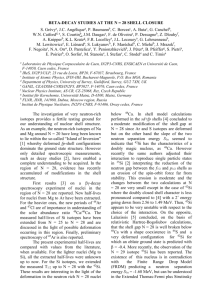
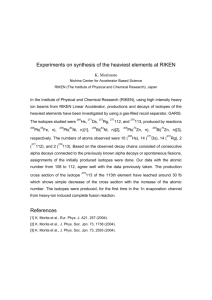


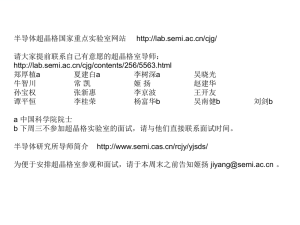
![paper_ed25_22[^]](http://s3.studylib.net/store/data/005874778_1-a76183b8bbb87cb1cdfe28832b638790-300x300.png)


